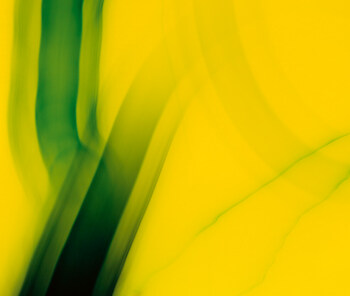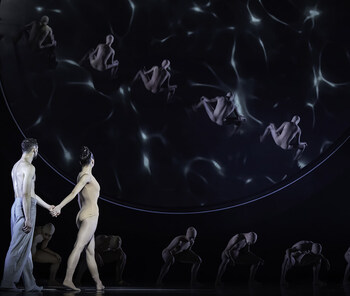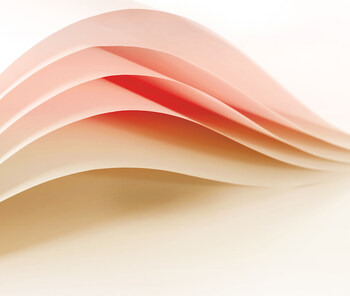David Dawson
Premiere 5. November 2022
World premiere
Piece-Info
It is one of the greatest love stories in the canon of Western literature: the passion and dreadful fate of young Romeo and his Juliet, who cannot be together because of deep-seated hatred and ancient quarrels, only to be united in death. William Shakespeare’s tragic tale has been reinterpreted countless times for the theatre, opera and dance stage as well the big screen, often updated to reflect current events and modern perspectives. The version of the famous ballet music by Sergei Prokofiev that we know today was created for Leonid Lavrovsky’s choreography for the Kirov Ballet, which premiered in St. Petersburg in 1940. »Romeo and Juliet« was first performed in Dresden in 1955. With »Romeo and Juliet«, the British Associate Choreographer of the Semperoper Ballett, David Dawson, presented his fourth full-length ballet in 2022. In Dawson’s vision, this is a world of jarring contrasts oscillating between order and chaos, between tenderness and strength–where the power of dance illuminates the tragedy and beauty of the story.
Act one
Among a crowd in a city square, a young man Romeo seeks the attention of Roseline, a Capulet. He is joined by his close and loyal friends Mercutio and Benvolio. The morning is interrupted by the arrival of Capulet’s nephew Tybalt, who is feared due to his cruelty and thirst for violence, and his bodyguards. Tybalt is taunted by Mercutio and a brawl ensues, started by Benvolio. Capulet appears with his guards and restores order by force. Mercutio and Benvolio plot to infiltrate a masked ball being held that evening at the Capulet’s palace and persuade Romeo to come as well. At the party, Capulet and Lady Capulet lead their guests in a dance. As Romeo seeks out Roseline, he sees Capulet’s daughter Juliet, who is being presented to Paris, a young man her parents have chosen for her to marry. As their eyes meet, Romeo and Juliet are struck by love. Tybalt discovers them together and alerts Capulet and Lady Capulet to the presence of the interlopers but, wanting no trouble in front of their guests, they permit them to stay. After the party, Romeo returns to the Capulets’s gardens, yearning to see Juliet again. Stepping out onto her balcony and thinking she is unobserved, Juliet proclaims her love for Romeo. Romeo appears to her and, alone with each other at last, their love unfolds. With a kiss they seal their destiny, and Romeo departs before he is discovered.
Act two
The next day, Juliet’s nurse mingles among the crowd in the square. She gives Romeo a letter from Juliet telling him to meet her at the chapel of Brother Laurence, who will marry them in secret. Romeo rushes to the chapel, and Brother Laurence blesses their union. Later, Tybalt arrives in the square looking for Romeo and tries to question Mercutio and Benvolio. Mercutio playfully taunts Tybalt, much to the approval of the citizens. Romeo returns from his wedding to Juliet, delirious with happiness. Tybalt turns his anger towards him, but Romeo wants only to make peace. Mercutio, seeking to defend Romeo, is mortally wounded during the fight with Tybalt and dies in Romeo’s arms. Devastated, Romeo attacks Tybalt in a blind rage. Romeo kills Tybalt and Benvolio hurries Romeo away, fearing the wrath of the Capulet family.
Act three
As dawn breaks, Romeo and Juliet awake after having spent their wedding night together. Juliet is distraught and begs Romeo to stay, but he must leave before he is discovered. The Capulets arrive, and her father insists that she must marry Paris immediately to help restore calm. She pleads and resists, but to no avail. Desperate, she runs to Brother Laurence asking for help. He gives her a potion that will cause her to fall into a death-like sleep, promising to send Romeo word to recover her from the Capulet family crypt. Returning to the palace, Juliet feigns her agreement to marry Paris, but later alone in her room drinks the potion. In the morning, her friends come to prepare her for the wedding, only to find her seemingly lifeless body.
Juliet is mourned as she lies in the crypt. News of her supposed death has reached Romeo. Mad with despair, he rushes to the crypt; then, overcome with grief, he drinks poison. Juliet awakens to find Romeo and, with no desire to live without him, kills herself with his dagger.
Gallery
Romeo and Juliet









Interview
Movement as obsession
Interview with the French set and costume designer Jérôme Kaplan about his work on »Romeo and Juliet« by David Dawson
When did you first come into contact with dance in your life?
I have to think of my older sister, who danced when she was a little girl. Then in the late 1970s, as a teenager, she danced as a soloist in the small town where we lived, in a style that was very modern – at least for that time. This is my earliest dance memory. I also have a Russian grandfather, and dance has always played an important role in this country.
What was your first ballet production in a professional context?
It was in 1991 in France, and we staged a ballet about two families - this idea came about because we were collaborating with another company. At the beginning of my career, I was mainly involved in opera and drama productions, but somehow, I always considered ballet much more exciting. In addition, movement becomes a real obsession for me when I draw and create. Precisely because I prefer depicting and creating for people in motion, I am also so attracted to dance. You can also present costumes in a static way and just exhibit them, but then they seem somehow lifeless to me. Especially with costumes for dance, I think it is important that both the persons wearing them and the garments can move, otherwise the pieces of clothing are not properly appreciated.
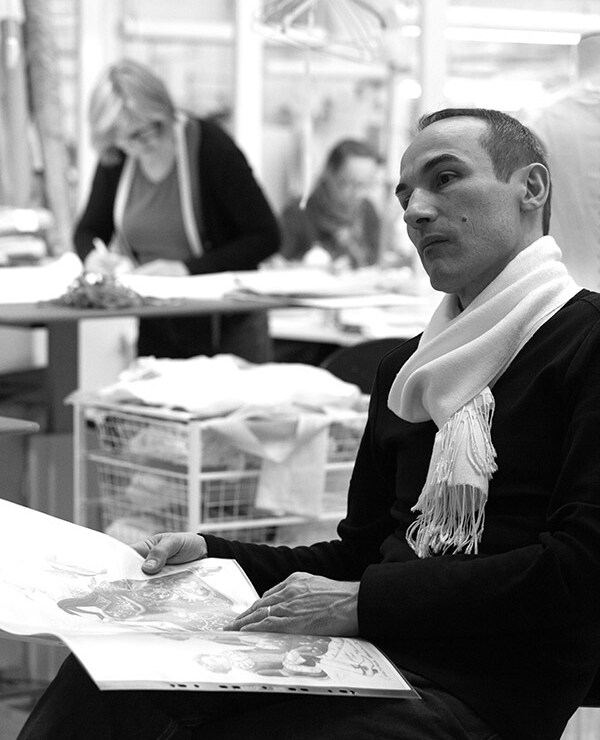
What is your relationship to »Romeo and Juliet«?
I regard myself very happy to once again be able to make this piece come to life as a set designer - for me it is now the fifth time. My first »Romeo and Juliet« production was in Monte Carlo in 1996. It was a great success – and it still is. And since the production has travelled a lot around the world, it has also opened up new opportunities for me, for example in China and South Korea. However, the basis of the success lies in the tragic love story and the combination of Shakespeare and Prokofiev's music.

An essential staging decision that probably confronts every production team of Romeo and Juliet is the question: classical or modern ...
The advantage is that every new constellation with a production team also requires a different and new way of thinking, so you always start from scratch - no matter how many times you may have staged the piece before. I have also staged many classical ballets in quite traditional settings. My answer to the question of time and space is: timeless. Because when I create, I always try to simplify. Especially with a story ballet such as »Romeo and Juliet«, the set can quickly become ›too much‹. Since the story line has not lost its topicality since Shakespeare, I think it is good to unite past, present and future in my work. I therefore quickly agreed with David Dawson to develop a timeless production. I think this is also important because theatre productions should ideally be able to last for several years, but also to be suitable for different venues. Precisely because dance is a universal language that is understood all over the world even without words, the décor should emphasise this universal legibility.
Has Prokofiev’s music influenced your creative work in any way?
Absolutely, very much so. I am always fascinated by the ›grandeur‹ that lies in his music. You strive yourself to create something beautiful, long-lasting, great, and then on the other hand there is a kind of sadness that is somehow interesting and comfortable. Owing to this identification with the moods that Prokofiev creates, I listened to a lot of his music online when I was designing the costumes for the different roles.
Ballet is a very physical and interpersonal art form. As a costume designer, what is particularly challenging for you in designing garments for dancers?
I think that a costume should somehow contribute to the creation of the movements. It should also make some things visible, even if the body itself is not directly visible but covered by the costume. For example, you have to be able to feel the leg under the fabric. I also think it is important – especially in classical dance – that you can see the feet. However, that always depends on the choreography and the basic aesthetic concept of the production. After all, the costume design also has to make sense in a dramaturgical way.



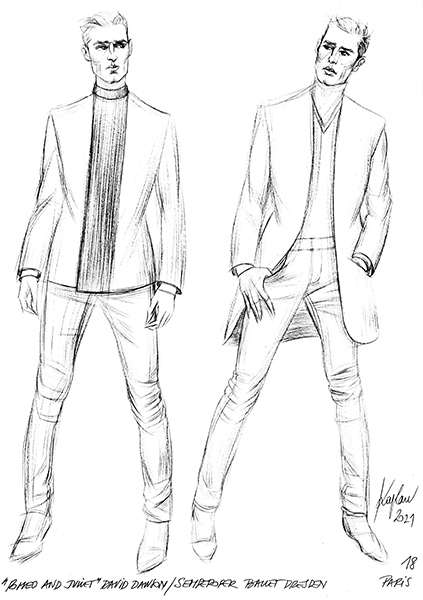
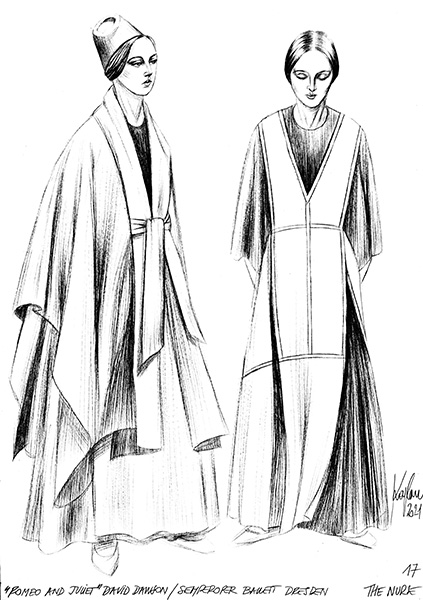
What colours and fabrics did you choose for your costumes in our production?
When I think about a costume - especially one in movement - the choice of the right fabric is extremely important. Of course, the scenic context must always be considered, as well as the question of the type and strength of lighting. In my opinion, colours play a significant role, especially when narrating action ballets, because the audience should be able to follow what is happening on stage – even from a distance – and understand the actions of the individual characters or groups of people.
Lady Capulet, for instance, was given a long, elegant gown in fiery red to stand out as the lady of the house from the Capulet family, who is dressed in softer shades of purple. Tybalt, the ›Bad Guy‹ wears a casual, sombre black with a biker jacket. Paris is got a khaki jacket similar in cut to that of Lord Capulet. This gives an associative link between the head of the family and his son-in-law-to-be. The Citizens, on the other hand, wear different shades of yellow, sand, grey and earth - that was quite a hard job for the dye works!
As for Juliet, David Dawson had suggested creating the same costume in different shades of nature tones to give her stage character a clear shape. She wears four different costumes made of light French chiffon silk; this fabric underlines Juliet's youthful temperament, full of lightness, but also symbolises the delicacy and fragility of a butterfly. Angelica, her nurse, on the other hand, wears rough silk, of which the jackets of Romeo, Mercutio and Benvolio are also made. They represent more grounded characters. The other Capulet ladies wear robes made of polyester; in contrast, the robes of the ladies of the Citizens are rather plain. Furthermore, all the gentlemen wear tights, the shapes and textures of which are based on blue jeans.
What inspired you in an architectural way for the set design of »Romeo and Juliet«?
The attractiveness of my job lies in travelling a lot and getting to know many different cultures and people. These diverse impressions inspire me and I can draw from them, so I in turn try to depict that in my set design. In the case of »Romeo and Juliet« with David Dawson, I decided to use a grey and black stone appearance for the surface of my set pieces. This idea goes back to my first visit to Dresden - the Florence of the North. If you look at the reconstruction of the Frauenkirche, for example, you are directly confronted with this light-dark contrast of the stones, whereas the darkening process of the sandstone reflects the passage of time.
A touch of the past or the Renaissance is perhaps also conveyed by the arches that I have integrated into my set design. Since the plot is characterised by many locations alternating between interiors and street scenes, I wanted to develop a kind of ›Lego system‹ – like in a painting by Piet Mondrian – to facilitate quick scene changes. The cypresses and the skyline are perhaps also a little reminiscent of Italy, but generally speaking, the décor should radiate our basic idea of time- and placelessness, because we can find Romeos and Juliets everywhere in the world.





Thank you very much for your time and these interesting insights!
Interview: Regina Genée

